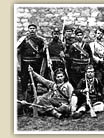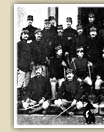
Due to the activity of the Exarchists, the devotion of the Patriarchist communities in Greece
was at stake and therefore future territorial claims on the part of Greece
on its northern frontier would be at risk. The first act was the dispatch to Macedonia of four young army
officers, in order to make an evaluation of the situation there. In the beginning of 1904 Alexandros Kontoulis,
Pavlos Melas, Anastasios Papoulas and Georgios Kolokotronis surveyed the Macedonian scene.
The view they formed was that the situation and correlations as have been shaped could only be
overturned by means of violent opposition. They claimed that Greek armed forces should immediately enter Macedonia, under the leadership of experienced and determined
officers, who would then organize local guerilla groups.
There were already in the area certain armed groups of Patriarchists such as that of Captain Kotas.
From August 1904 Pavlos Melas was appointed Commander-in-Chief of the Greek guerrillas of western
Macedonia. In the same month, Mikis Zezas (his nom de guerre), along with a group of Cretan guerrillas,
crossed the frontier. He operated in the area of Kastoria and in October of that same year
was killed during an engagement with a Turkish military unit. His death caused a more active interest
in Greek claims and activated many of his fellow army officers.
From the end of 1904 there was an increase in Greek guerilla activity - the Makedonomakhoi group for example, deployed in Macedonia, under the leadership of Konstantinos Mazarakis Ainian, Tsontos Vardas,
Efthimios Kaoudis, Spyros Spiromilios and others.
|
 |

Many of the Makedonomakhoi originally came from Crete and other areas outside Macedonia. Throughout 1905
and 1906 they participated in several engagements with groups of armed komitadjis and in operations
in villages that adhered to the Exarchate in order to take them back to the Patriarchate. In large
urban centres and especially in Thessaloniki the juxtaposition took the form of an economic war
between Bulgarian and Greek inhabitants. In 1906 interest in the armed struggle
focused on the area of the Lake of Yanitsa, the 'Marsh', which was of supreme strategic importance for the control of the communications and trade routes of central Macedonia. The Greek struggle
was headed by Telos Agapinos, Captain Agras, who was killed in an ambush in Pella.
In the following period conflict remained firm. However, the intense Bulgarian presence
and activity of the previous years was dealt with and the Patriarchist villages
were protected. With the outbreak of the Young Turk revolution in 1908 the Greco-Bulgarian clashes
practically ceased in Macedonia. A contributory factor was the Young Turks' initial proclamation about equality before the law (regardless of nationaly) and the imposition of law and order in the Empire. Naturally the activity of the Exarchists and the Greek armed groups did not stop
altogether. The whole issue however, was to be definitely resolved a few years later during the Balkan Wars,
when the fate of the populations and territories of Macedonia were definitively decided upon.
|
 |
